Next-Scale Prediction、InstantStyle、Co-Speech Gesture Generation
本文首发于公众号:机器感知
Next-Scale Prediction、InstantStyle、Co-Speech Gesture Generation

Visual Autoregressive Modeling: Scalable Image Generation via Next-Scale Prediction
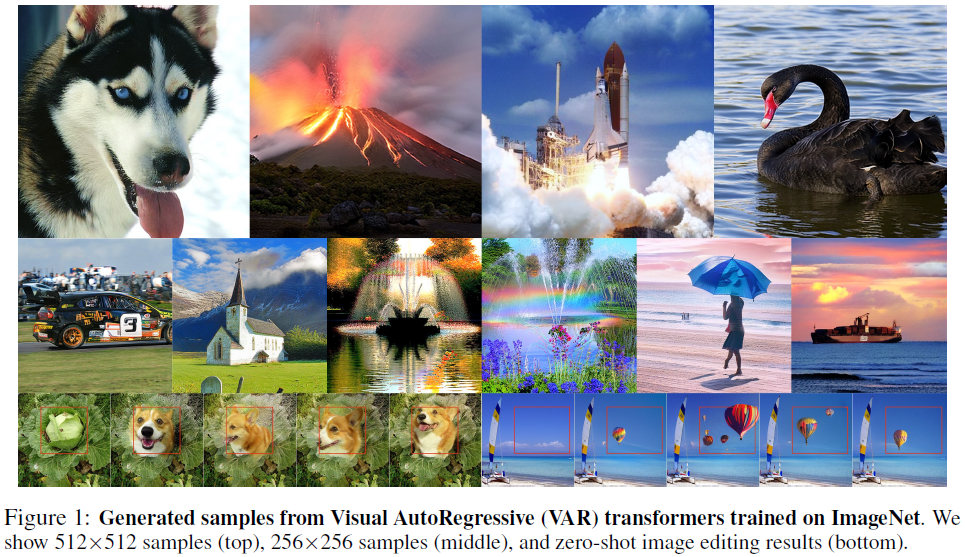
We present Visual AutoRegressive modeling (VAR), a new generation paradigm that redefines the autoregressive learning on images as coarse-to-fine "next-scale prediction" or "next-resolution prediction", diverging from the standard raster-scan "next-token prediction". This simple, intuitive methodology allows autoregressive (AR) transformers to learn visual distributions fast and generalize well: VAR, for the first time, makes AR models surpass diffusion transformers in image generation. On ImageNet 256x256 benchmark, VAR significantly improve AR baseline by improving Frechet inception distance (FID) from 18.65 to 1.80, inception score (IS) from 80.4 to 356.4, with around 20x faster inference speed. It is also empirically verified that VAR outperforms the Diffusion Transformer (DiT) in multiple dimensions including image quality, inference speed, data efficiency, and scalability. Scaling up VAR models exhibits clear power-law scaling laws similar to those observed in LLMs, wit......
BAdam: A Memory Efficient Full Parameter Training Method for Large Language Models
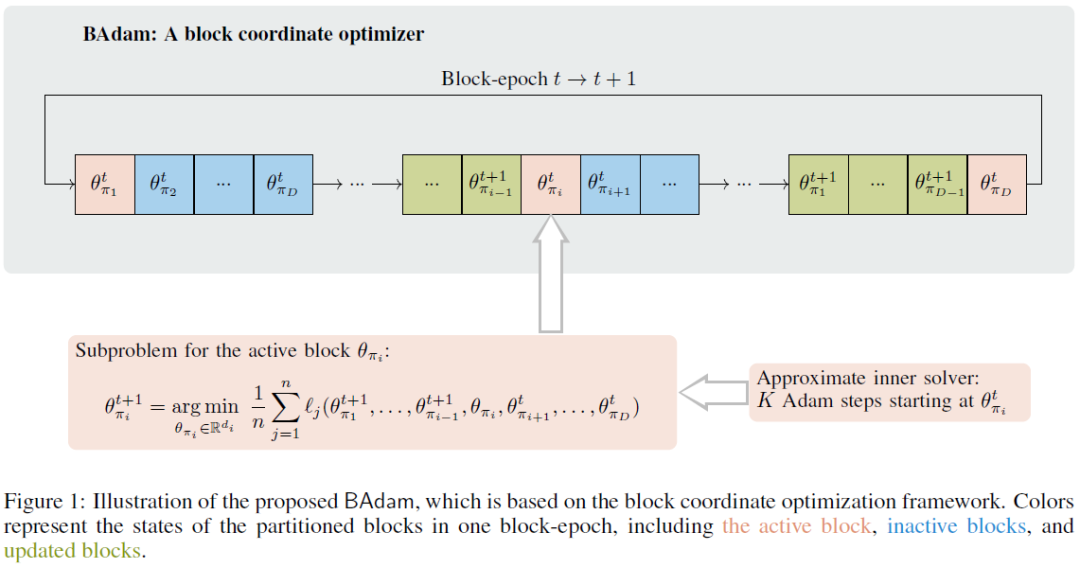
This work presents BAdam, an optimizer that leverages the block coordinate optimization framework with Adam as the inner solver. BAdam offers a memory efficient approach to the full parameter finetuning of large language models and reduces running time of the backward process thanks to the chain rule property. Experimentally, we apply BAdam to instruction-tune the Llama 2-7B model on the Alpaca-GPT4 dataset using a single RTX3090-24GB GPU. The results indicate that BAdam exhibits superior convergence behavior in comparison to LoRA and LOMO. Furthermore, our downstream performance evaluation of the instruction-tuned models using the MT-bench shows that BAdam modestly surpasses LoRA and more substantially outperforms LOMO. Finally, we compare BAdam with Adam on a medium-sized task, i.e., finetuning RoBERTa-large on the SuperGLUE benchmark. The results demonstrate that BAdam is capable of narrowing the performance gap with Adam. Our code is available at https://github.com/Ledzy/......
MULAN: A Multi Layer Annotated Dataset for Controllable Text-to-Image Generation

Text-to-image generation has achieved astonishing results, yet precise spatial controllability and prompt fidelity remain highly challenging. This limitation is typically addressed through cumbersome prompt engineering, scene layout conditioning, or image editing techniques which often require hand drawn masks. Nonetheless, pre-existing works struggle to take advantage of the natural instance-level compositionality of scenes due to the typically flat nature of rasterized RGB output images. Towards adressing this challenge, we introduce MuLAn: a novel dataset comprising over 44K MUlti-Layer ANnotations of RGB images as multilayer, instance-wise RGBA decompositions, and over 100K instance images. To build MuLAn, we developed a training free pipeline which decomposes a monocular RGB image into a stack of RGBA layers comprising of background and isolated instances. We achieve this through the use of pretrained general-purpose models, and by developing three modules: image decompo......
Cross-Attention Makes Inference Cumbersome in Text-to-Image Diffusion Models
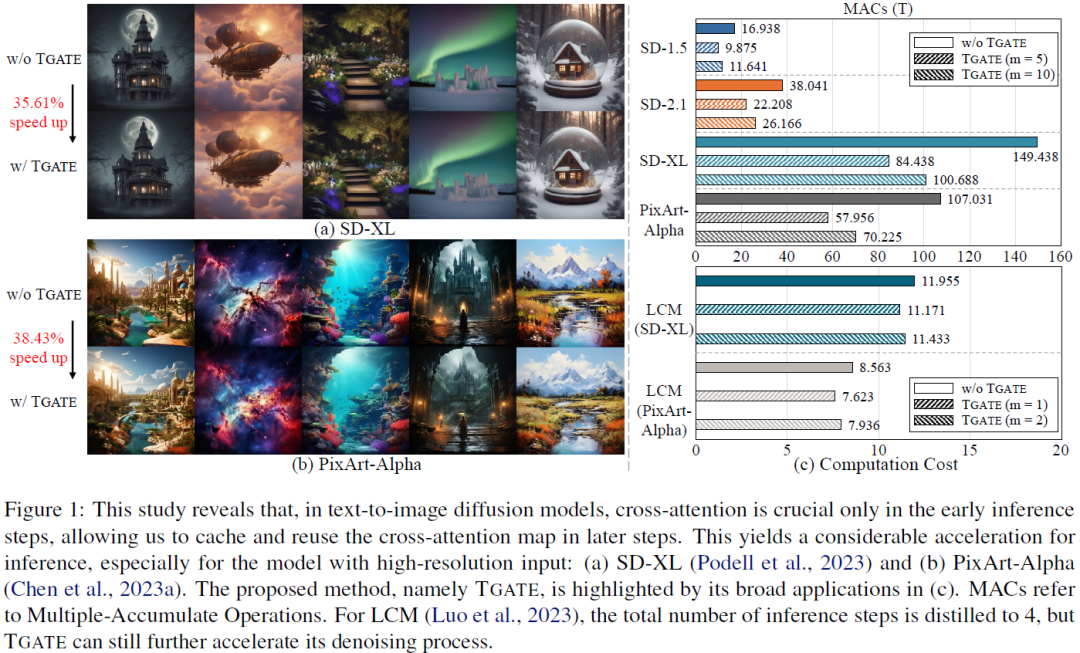
This study explores the role of cross-attention during inference in text-conditional diffusion models. We find that cross-attention outputs converge to a fixed point after few inference steps. Accordingly, the time point of convergence naturally divides the entire inference process into two stages: an initial semantics-planning stage, during which, the model relies on cross-attention to plan text-oriented visual semantics, and a subsequent fidelity-improving stage, during which the model tries to generate images from previously planned semantics. Surprisingly, ignoring text conditions in the fidelity-improving stage not only reduces computation complexity, but also maintains model performance. This yields a simple and training-free method called TGATE for efficient generation, which caches the cross-attention output once it converges and keeps it fixed during the remaining inference steps. Our empirical study on the MS-COCO validation set confirms its effectiveness. The sourc......
InstantStyle: Free Lunch towards Style-Preserving in Text-to-Image Generation
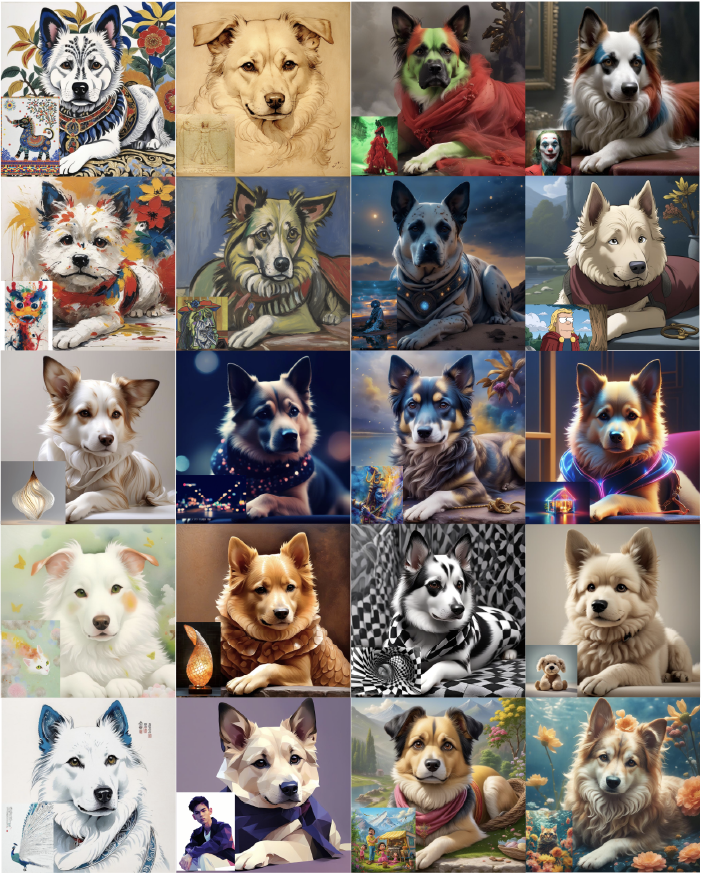
Tuning-free diffusion-based models have demonstrated significant potential in the realm of image personalization and customization. However, despite this notable progress, current models continue to grapple with several complex challenges in producing style-consistent image generation. Firstly, the concept of style is inherently underdetermined, encompassing a multitude of elements such as color, material, atmosphere, design, and structure, among others. Secondly, inversion-based methods are prone to style degradation, often resulting in the loss of fine-grained details. Lastly, adapter-based approaches frequently require meticulous weight tuning for each reference image to achieve a balance between style intensity and text controllability. In this paper, we commence by examining several compelling yet frequently overlooked observations. We then proceed to introduce InstantStyle, a framework designed to address these issues through the implementation of two key strategies: 1)......
Language Models as Compilers: Simulating Pseudocode Execution Improves Algorithmic Reasoning in Language Models
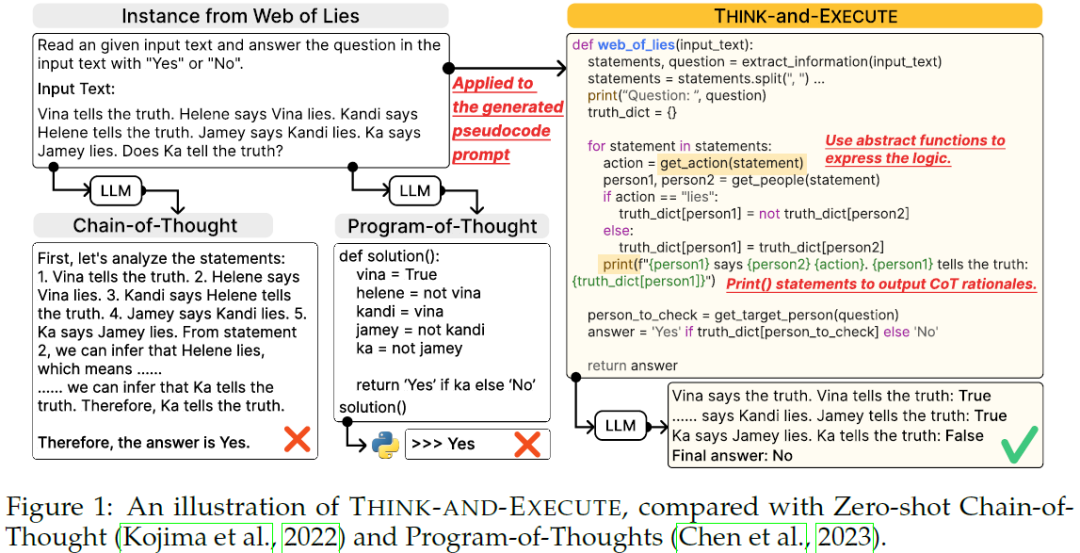
Algorithmic reasoning refers to the ability to understand the complex patterns behind the problem and decompose them into a sequence of reasoning steps towards the solution. Such nature of algorithmic reasoning makes it a challenge for large language models (LLMs), even though they have demonstrated promising performance in other reasoning tasks. Within this context, some recent studies use programming languages (e.g., Python) to express the necessary logic for solving a given instance/question (e.g., Program-of-Thought) as inspired by their strict and precise syntaxes. However, it is non-trivial to write an executable code that expresses the correct logic on the fly within a single inference call. Also, the code generated specifically for an instance cannot be reused for others, even if they are from the same task and might require identical logic to solve. This paper presents Think-and-Execute, a novel framework that decomposes the reasoning process of language models into ......
A Unified Editing Method for Co-Speech Gesture Generation via Diffusion Inversion
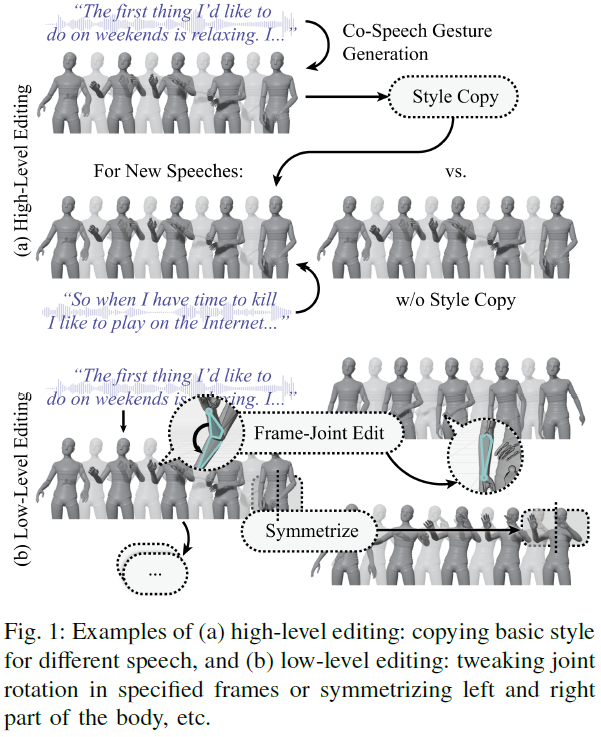
Diffusion models have shown great success in generating high-quality co-speech gestures for interactive humanoid robots or digital avatars from noisy input with the speech audio or text as conditions. However, they rarely focus on providing rich editing capabilities for content creators other than high-level specialized measures like style conditioning. To resolve this, we propose a unified framework utilizing diffusion inversion that enables multi-level editing capabilities for co-speech gesture generation without re-training. The method takes advantage of two key capabilities of invertible diffusion models. The first is that through inversion, we can reconstruct the intermediate noise from gestures and regenerate new gestures from the noise. This can be used to obtain gestures with high-level similarities to the original gestures for different speech conditions. The second is that this reconstruction reduces activation caching requirements during gradient calculation, makin......
Prompts As Programs: A Structure-Aware Approach to Efficient Compile-Time Prompt Optimization

Large language models (LLMs) can now handle longer and more complex inputs, which facilitate the use of more elaborate prompts. However, prompts often require some tuning to improve performance for deployment. Recent work has proposed automatic prompt optimization methods, but as prompt complexity and LLM strength increase, many prompt optimization techniques are no longer sufficient and a new approach is needed to optimize {\em meta prompt programs}. To address this, we introduce SAMMO, a framework for {\em compile-time} optimizations of metaprompt programs, which represent prompts as structured objects that allows for a rich set of transformations that can be searched over during optimization. We show that SAMMO generalizes previous methods and improves the performance of complex prompts on (1) instruction tuning, (2) RAG pipeline tuning, and (3) prompt compression, across several different LLMs. We make all code available open-source at https://github.com/microsoft/sammo .......
Linear Combination of Saved Checkpoints Makes Consistency and Diffusion Models Better
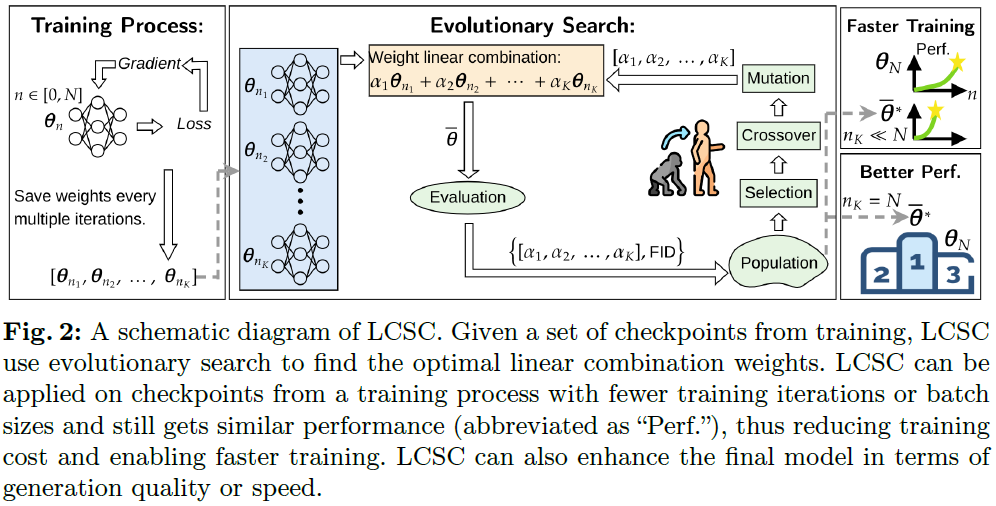
Diffusion Models (DM) and Consistency Models (CM) are two types of popular generative models with good generation quality on various tasks. When training DM and CM, intermediate weight checkpoints are not fully utilized and only the last converged checkpoint is used. In this work, we find that high-quality model weights often lie in a basin which cannot be reached by SGD but can be obtained by proper checkpoint averaging. Based on these observations, we propose LCSC, a simple but effective and efficient method to enhance the performance of DM and CM, by combining checkpoints along the training trajectory with coefficients deduced from evolutionary search. We demonstrate the value of LCSC through two use cases: $\textbf{(a) Reducing training cost.}$ With LCSC, we only need to train DM/CM with fewer number of iterations and/or lower batch sizes to obtain comparable sample quality with the fully trained model. For example, LCSC achieves considerable training speedups for CM (23$......
